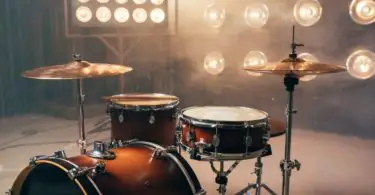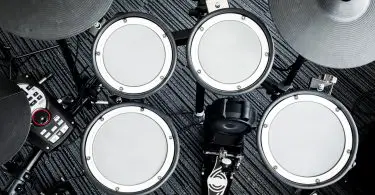In the marching band world, musicians are only as good as the equipment they have to support their instruments. When they step out onto the field or take their spot in the big parade, they need to feel their instruments are secure in order to play their best. For some players, this means cutting off the tips of their gloves for a better grip on their valves, and for some, it means a good neck clip.
But for the percussionists, there is some serious equipment involved in marching with drums. You absolutely must have a carrier, which is an uncomfortable-looking metal contraption that hangs from the shoulders to suspend the instrument in front of the player, leaving the arms free to play. It must be secure so the drum doesn’t fall during performance, lightweight to prevent fatigue, and durable to take years and years of practicing, performing, and transporting.
There is good quality found among the major brands, such as Pearl, Yamaha, Dynasty, and Randall May. All of the band teachers and students we talked to agreed that all of these brands have quality equipment. Basically, you will want to look at comfort and convenience features to make the best choice for your marching musician.
We really cannot recommend one carrier as “the best” because things like the size of the marcher and instrument being carried make a difference, but we will steer you in the direction of those that we think have superior or unique features that may make your marcher’s life a little more comfortable on the field.
Top of the line in adjustability, comfort, and light weight. Our opinion is that this is the cadillac of marching band equipment - the "we've thought of everything" instrument carrier.
I have been blessed to be a marching band mom for the last seven years and an orchestra mom for the last five years. From putting gauntlets on hundreds of marchers as they prepare for competition to emergency, MacGuyver style equipment repairs on the field; from finding the missing rock stop to loading instruments larger than I am into trailers, being a music parent truly is my life.
I am confident in the recommendations you are about to read after spending hours sifting through all the major retailers (and some of the lesser known, too), reading manufacture specs and product pages, and speaking with the award-winning band directors in my school district about their preferences.
Most importantly, I talked to some experts – band kids themselves – to find out the good and the bad on the field. As it turns out, they just want to be able to put on and take off their equipment quickly and easily, and to not be crying in pain at the end of the day. Everything else is, reportedly, just a bonus. It’s really not about the way the equipment looks but the way it performs.
My kids play multiple instruments, from strings to winds to percussion, so I am constantly seeking the very best value and quality for my money. The last thing music parents want to do is buy something twice because the first product didn’t work as needed. I have been very thorough in my research for you so that you can make a truly informed decision when you make your purchase.
-
 $379.99Check on Amazon Search Used
$379.99Check on Amazon Search UsedTop of the line in adjustability, comfort, and light weight. Our opinion is that this is the cadillac of marching band equipment - the "we've thought of everything" instrument carrier.
06/28/2025 09:11 pm GMT -
-
 Check on Amazon Search Used
Check on Amazon Search UsedDesigned to support proper spinal alignment with its ABS (articulating back support) system that evenly distributes weight.
How Do I Choose a Carrier?
The right carrier will allow the musician to march comfortably, enhancing playing ability. If your marcher isn’t comfortable (say his range of motion is restricted by the way the carrier fits – or doesn’t fit) he’s not going to play his best. He may miss getting to his dot at the right count if he can’t march quickly or comfortably.
A carrier that pinches, presses against bones, or puts too much strain on the lower back will greatly restrict the player’s ability to perform at top notch. Likewise, an instrument carrier that can’t be adjusted to allow the legs to move freely will restrict a player from high stepping and side stepping. Be sure your player has a free range of motion in arms and legs with the carrier on his body.
The carriers we discuss here are for percussionists who march and are not specific to any certain drum, such as snare, tenor, bass, etc. Each manufacturer has carriers specific to each instrument, but we will discuss the brand and product line as a whole. The carrier is worn over the shoulders to hold the instrument, allowing the hands to be free for hitting the drum.
Harness
A fabric harness can go around the back to secure the contraption while a tubular metal (usually aluminum) frame goes over the shoulders and all the way to the pelvis to cradle the instrument. Some drums snap in, some lock in, and some simply slide into position. Your needs will be based on the band director’s expectation for movement. The basic design is intended to spread the weight over the entire torso of the player to reduce fatigue and strain on the lower back, and some designs achieve this better than others.
Measurements
You will need some rough measurements of your musician to properly select the right carrier. Height, weight, and shoulder breadth can all make a difference in the carrier you choose as some are better than others for marchers who are particularly short, tall, or wide.
The best carriers have many adjustment points, such as the height of the belly or abdominal plate, the tow-in or distance between shoulder blades, the length of the shoulder braces, and the back bar (some have this and some don’t). In addition, the fabric harness on the back (if available) should offer fine tuning of the perfect fit.
Fit
Putting on a drum carrier for the first time can seem a little intimidating, and if it is not adjusted and worn correctly the marcher won’t be able to play well. Students who are new to marching will struggle a bit to find the fit that is the most comfortable and their constant complaining that first year of band camp will undoubtedly be the bane of your existence.
Hold tight – they’ll get over it before you know it and become a seasoned pro. Just to be sure you are able to help understand what they have to go through, check out this video that shows how to wear and adjust a carrier.
Padding
A player with bony shoulders or a very narrow frame will appreciate generous padding in the shoulder area of the carrier as this is the heaviest part to rest against the body. Most companies do sell extra padding made specifically for their instrument carriers, but in a pinch some pipe insulation or even hat band foam has been known to work wonders! Pay attention to places that might pinch or rub and consider the ability to make adjustments at those points.
Body Type
Look for a quality instrument carrier that is comfortable for the size of your specific player. Most carriers are based on an average young adult size body, so if your player is still pretty small you may need to try on more styles to find the one that fits best. All carriers are not made equally – some are designed for smaller, younger players while most are designed for adult size bodies. Much larger body types need to pay careful attention to the ability to adjust the shoulder hooks, in particular.
If possible, have your musician with you when you’re looking through this review. I can tell you if a carrier is best for someone who is 5’ tall, but only your musician can tell you if that recommendation applies to them as some people carry their height in their legs and some in their torso.
If your marcher is a very average size (let’s say 5’8, 125 lbs, average shoulder width), then it’s not necessary to worry about extenders on shoulder bars or a belly plate that adjusts to fit someone who is 4’9” or 300 lbs. You can save yourself some work simply by acknowledging your marcher’s body type and size before making a selection.
Weight
Lightweight is not necessarily the only deciding feature of an instrument carrier. Musicians say that they prefer comfort over weight, so look for equipment that has padding in the right places and secure brackets for the instrument that will be carried. Our top picks are definitely lightweight and yes, this is a desirable feature!
However, we are just saying don’t discount a model just because lightweight is not one of its top features. Other factors, such as adjustability and padding, may be more important to your particular marcher. In the same respect, if your band director expects a lot of high energy moves from the drumline, you may have to have a slightly heavier piece of equipment that will securely hold the instrument through some wild dance steps. Be sure to talk to your band director about his expectations!
Price
Remember that you are often paying for a name when it comes to equipment. Reviews and features come before price – a carrier is not necessarily better just because it is more expensive. In fact, a few teachers we spoke with said they wouldn’t even consider a couple of the more expensive brands out there due to lack of compatibility with a wide variety of student body sizes.
Of course, they are buying for a wide variety of student needs and you are buying for one student, so just be sure you’re not buying equipment just because the name matches the bumper stickers on your marcher’s notebook or that is endorsed by a popular musician, because everything important is not only in a name.
Warranty
Finally, check guarantees, warranties, and return policies before making your final purchase. This is very important as your musician may not know something isn’t right until they’ve worn the equipment a bit. Buying local could be a better choice than buying online just for the relationship with the shop owner and the ability to return something if it doesn’t work.
If you find a better price online, ask a shop if they can match that price. If not, buying online does have its benefits, such as getting the equipment delivered straight to your door and getting the best price. Always get warranty and return policy information in writing, either printed directly from the website, sent in an email, or from the shop owner.
Our Recommendation: Pearl CX Airframes

Credit: PEARL CORPORATION.
Pearl CX Airframes get our top recommendation because of their adjustability, comfort, and light weight. Our opinion is that this is the cadillac of marching band equipment – the top of the line, “we’ve thought of everything” instrument carrier.
Top of the line in adjustability, comfort, and light weight. Our opinion is that this is the cadillac of marching band equipment - the "we've thought of everything" instrument carrier.
Pearl has created a carrier that is everything a marcher can hope for in one piece of equipment. They watched marchers, asked questions, talked to band directors, took their advice, and created an amazing product. Pearl CX Airframes are lightweight, simple in design, and durable.
This carrier has been designed for years of use and has solid accolades from field testing by some of the best in competition – namely Santa Clara Vanguard and the Blue Knights – and you really don’t get better than that. This is the carrier designed for high-intensity marching bands who expect 100% from every member, even if that means the drum line is doing crazy turns and dance moves. The Pearl CX Airframes have literally got your back. From the Pearl website:
“The CX AIRFRAME Carriers feature a solid rod, form-fitting upper shoulder frame attached to a thin aluminum belly plate with extreme range of motion. The ACS (Agility Control System) Belt unites the player to their instrument for optimal stability in today’s modern use of body movement. The shoulder and belly pads are removable for cleaning and are built with a “Stealth” design; the Carriers practically disappear under the uniform. The new CXBB-1 Tenor back bar provides absolute level positioning of all of the toms and features a lightweight aluminum construction. For the first time, the customer will have the option to have a 6” AND 8” tom in their sextuplet configuration.”
Ask any drummer who has marched through a week of band camp how glorious it would be to remove the shoulder and belly pads for washing, and they may just cry for joy. Band moms everywhere rejoice! Reducing bulk under the uniform is highly desirable for band directors, and range of motion is pretty much the most important aspect of carrier choice. Being able to move as though you weren’t wearing a bulky metal frame from your shoulders to your hips is an amazing feat, and we think Pearl nailed it.
Features:
- Removable shoulder pads for cleaning
- ACS Belt unites instrument with player
- No small parts to maintain
- Fully adjustable with a standard drum key
- Stealth design disappears under uniform
We feel like Pearl really gets the idea of what talented marchers really need in today’s high energy, everyone included marching shows. They understand what band directors and choreographers are asking of the drumline, which is way more movement than the shows of ten or twenty years ago. These days percussionists are expected to march and dance with some serious energy and Pearl is meeting today’s band directors on the field in terms of flexibility.
Runner Up: Yamaha Field Corps Aluminum Tubular

Credit: Yamaha Corporation
Yamaha Field Corps Aluminum Tubular Carriers get our second nod basically for their incredible adjustability. This is a carrier worth the money because your player can use it through those crazy high school growth spurts. The frames are very lightweight yet super strong, and they can adjust to fit almost any height marcher, from a very petite and thin player to a linebacker who doubles as a snare player.
Second nod basically for their incredible adjustability.
Everything on these carriers is adjustable, from the height of the belly plate to the width of the shoulder pads and even the angle/tow-in adjustment. The back bar and hinge are also fully adjustable for a totally customized fit.
Other Carrier Brands to Consider:
Because there are so many instrument carriers available on today’s market, we thought it would be best to list some others we compared when looking for the best. These are all great brands worth checking out, and really, any of them are worth their price.
The differences will be subtle – some have patented designs, some have extra features. Your marcher might like some of the extra features, or he might like the basics. You will find a little of everything below. When in doubt, talk to your band director if you still need more advice on choosing the right equipment.
Dynasty T-Max SEM System Carrier
The Dynasty SEM (Single Entry Mount) system ditches the traditional J-bars found on other carriers and allows quick and easy mounting of the drum. The carrier’s unique design relieves pressure on the player’s neck and shoulders by shifting the majority of the instrument’s weight to the player’s hips – a great idea especially for carrying heavier drums.
The player can easily adjust the drum height without help using the proprietary sliding track system. Velcro closures on the padding make for quick and easy adjustments and allow for easy replacement when pads get worn. We’ve found the Dynasty to be comfortable for extended wear and durable.
Mapex Contour Hinge Monoposto Carrier

Credit: Randall May International, Inc
The Monoposto carrier by Randall May has one of the most unique features of all the carriers we reviewed – it can be folded to about half its size for easier transportation. Okay, maybe we are impressed by shiny things, but when you’re transporting percussion instruments anything that saves space is welcome!
Designed to support proper spinal alignment with its ABS (articulating back support) system that evenly distributes weight.
The Monoposto is designed to support proper spinal alignment with its ABS (articulating back support) system that evenly distributes weight. The abdomen plate is made of a light polycarbonate designed to bear no weight from the drum itself – a great feature for easy breathing.
The Mapex is one of the more expensive products we looked into, and a lot of band directors actually do not like the fit, even with the contour hinge, for players other than average size.
Tama Starlight Carriers / CSASDM

Credit: TAMA MARCHING DRUMS & PERCUSSION
Tama has designed their Starlight carriers with a special locking system to securely hold the drum in place. The carrier features a noiseless carrier attachment, which can be helpful in dramatic marching show moments, decreasing the amount of extra noise heard on the field (field judges will be impressed).
Special bumpers help protect your instrument by preventing the carrier from touching the drum during attachment and detachment. The design is sleek and the abdominal plate is fully adjustable, but there are not as many adjustments as on some of the other models we’ve reviewed.
Tama Starlight Carriers have a lower price point to go with their more simplistic design.
To recap here’s the full competition:
Top of the line in adjustability, comfort, and light weight. Our opinion is that this is the cadillac of marching band equipment - the "we've thought of everything" instrument carrier.
Second nod basically for their incredible adjustability.
Designed to support proper spinal alignment with its ABS (articulating back support) system that evenly distributes weight.










Start the discussion at talk.hearthemusicplay.com